Soft and creamy on the inside and crunchy on the outside, Japanese Croquettes or Korokke is my absolute favorite Japanese food. This is my mother’s best recipe and I’m sharing her secrets with you.

If there was one food that I must have when I visit my parents back in Japan, it would be Japanese Croquettes or Korokke (コロッケ). Not any kind of korokke but the ones that my mother makes. I could never resist the crispy panko exterior that breaks away into a luscious potato and meat mixture. It is the most delicious and comforting reminder of home!
Today I’m going to share my mother’s recipe. She often tweaks her korokke as a way to explore new flavors, such as one time she added miso for an extra boost. You too can do the same! Feel free to add a dash of curry powder, incorporate carrot and shiitake mushrooms (see this recipe), or swap the potato and meat with kabocha (see this recipe).

What are Japanese Croquettes?
Japanese croquettes are called Korokke (コロッケ) and the classic style is made of mashed potatoes mixed with sauteed ground beef and onion. The flat oval-shaped patties are breaded with light and airy panko breadcrumbs and deep-fried till golden brown and crispy.
Korokke was introduced in Japan around the late 1800s as a potato filling instead of the traditional French creamy croquettes due to the lack of dairy in Japan. These Japanese potato croquettes became one of the top 3 popular Yoshoku (western-influenced dishes) in the early 1900s (Taisho period) along with beef steak and Tonkatsu.
In Japan, Korokke is a homemade food as well as a street food. You can buy fried korokke to take home at butcher shops, order it at diners and restaurants, and buy it in pre-cooked food (Sozai) and bento section at supermarkets and convenience stores.
Having tasted my mom’s homemade korokke, I just couldn’t bring myself to eat the ones from the stores or restaurants because they are made of mostly potatoes and the taste is rather bland. That’s why you have to make them yourself at home!
Why You’ll Love This Korokke
- More meat for extra flavor – My mother’s recipe includes more meat than most recipes or store-bought. Never too plain.
- Crunchy shell on the outside, and slightly chunky, starchy texture on the inside.
- Great for making ahead (meal prep) and easy to reheat!
- Perfect for packing in bento (make mini sizes!)
- Another delicious panko-breaded dish you can eat with your favorite Tonkatsu sauce.

4 Key Ingredients to Make Korokke
It’s important to get the right quality ingredients, especially for a simple recipe like this. Please read below carefully.
1. Russet Potatoes
In the US, the most common potatoes are Russet potatoes, red potatoes, and Yukon Gold potatoes. For making Korokke, the Russet potatoes are the ideal choice since the starchy, fluffy, and light texture makes for the perfect bite. They are the best at soaking up the juice and flavor from the meat and onion.
If you’re in Japan, there are “May Queen” (メークイン) and “Danshaku” (男爵) potatoes. For Korokke, use Danshaku or do as my mom who uses roughly 85-90% Danshaku and adds 10-15% May Queen because she likes to be different… She also believes she should boil potatoes with the skin on, and then peel it with fingers while they are hot. Because it could possibly burn fingers, I excuse myself for not following her method 100%.
2. High-Quality Ground Beef
Typically, Japanese croquettes use ground beef but sometimes can use ground pork. I usually use high-quality 85% lean ground beef for more flavor. The korokke sold from the butcher shops are delicious, and you know the reason – high-quality meat!
You can use ground turkey or chicken, but I think the flavor could be a little lacking compared to beef.
For those who want to make a vegan/vegetarian version, you can omit the meat completely. Instead, switch it with finely chopped shiitake mushrooms or other mushrooms you have. You can also add dense vegetables such as corn and carrot, which do not have much moisture, but you can also sauté them until the moisture is evaporated.
3. Yellow Onion
I use yellow onions whenever I caramelize or stir fry till golden. The amount of flavor and sweetness you’ll get from cooking those yellow onions, as opposed to other kinds, is significantly higher. The key is to stir-fry until the moisture evaporates so the croquettes do not contain extra moisture. For a nice char, leave the chopped onion for a long stretch of time between stirring.
4. Panko (Japanese breadcrumbs)
Try finding Japanese brand breadcrumbs called Panko. The light, airy, larger flakes tend to stay crispier longer than standard breadcrumbs because they don’t absorb as much grease. See the brand I normally use in this post.

5 Important Tips for Making Korokke Patties
Read these tips carefully before you start cooking!
1. Start boiling the potatoes from cold water.

I learned to boil root vegetables from cold water as a method to protect the shapes and textures. That means you add the potatoes and water in the pot at the same time, as opposed to adding them later to the boiling water.
Due to the density of potatoes or any root vegetables for this matter, it takes a long time for the heat to reach the center. Therefore it’s best to start cooking them from water to prevent the skin or outer layer from disintegrating before the inside is cooked.
2. Moisture is a big no-no!
During the cooking process, it’s important to remember not to introduce moisture to the patties. There are 3 cooking steps in this recipe where you should remove excess moisture.

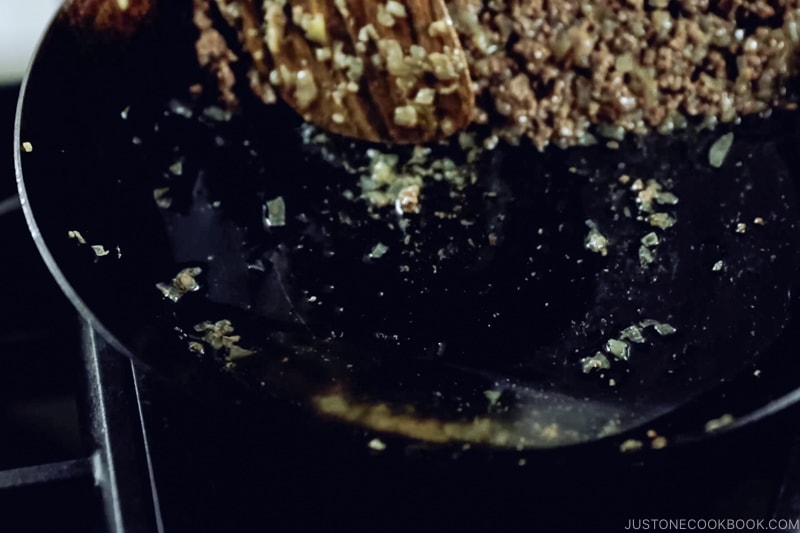

3. Mash and season the potatoes while hot.
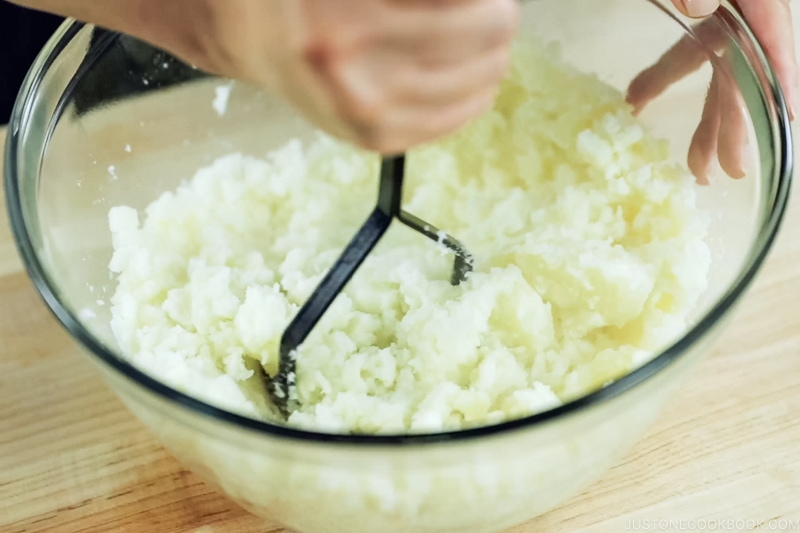
While the potatoes are hot, mash and let the steam escape. My mom usually keeps some potato chunks unmashed to create texture. Season the potatoes and add the meat mixture while the potatoes are hot so that they will absorb all the flavor. Do not knead the mixture (you don’t want it mushy!); gently combine well together.
4. Do not include the air.

When you’re shaping the potato and meat mixture into an oval patty shape, try not to include air pockets.
5. Let the patties cool completely before breading.

This step is very important. Resting and cooling down the patties prevents the korokke from exploding while deep frying. The cold patties in the hot oil will not release any steam; therefore korokke will not explode in the oil. It also helps the ingredients to meld together.

Helpful Tips for Deep Frying
The best part of deep frying Korokke, besides how delicious it is, is that the inside gets cooked fully. You do not need to worry about undercooking. This is why I believe Korokke is one of the easiest foods to practice deep frying.

Here are my tips for deep frying Korokke.
- Add enough oil to cover the croquettes completely.
- Use a cooking thermometer to check the oil temperature (no guessing!). Once you are used to it, you can use the chopstick or panko tricks to determine the oil temperature.
- Deep fry 2-3 pieces at a time. When you put too many pieces, the oil temperature will drop too quickly and the Korokke will absorb too much oil.
- Once you add the Korokke in the oil, don’t touch until it turns golden brown on one side.

How to Bake Korokke instead of Deep-Frying
I knew you would ask if you can bake instead of deep-frying! I got you covered. I do have a recipe for Baked Croquette!
Wish to learn more about Japanese cooking? Sign up for our free newsletter to receive cooking tips & recipe updates! And stay in touch with me on Facebook, Pinterest, YouTube, and Instagram.

Japanese Croquettes (Mom‘s Korokke)
Ingredients
For the Potato and Meat Mixture
- 2 lb russet potatoes (about 4 potatoes)
- 1 onion (9.6 oz, 272 g)
- 1 Tbsp neutral oil
- 1 lb ground beef (85% lean)
- ½ tsp Diamond Crystal kosher salt (for the meat)
- ¼ tsp freshly ground black pepper (for the meat)
- 1 Tbsp unsalted butter (for the potatoes)
- ½ tsp Diamond Crystal kosher salt (for the potatoes)
- ¼ tsp freshly ground black pepper (for the potatoes)
For the Panko Breading
- ½ cup all-purpose flour (plain flour)
- 2 cups panko (Japanese breadcrumbs)
- 3 large eggs (50 g each w/o shell)
For Deep-Frying
- 4 cups neutral oil (or enough for 2 inches or 5 cm of oil in the pot)
For Serving
- tonkatsu sauce (or make my Homemade Tonkatsu Sauce)
Instructions
- Gather all the ingredients.

To Make the Potato and Meat Mixture
- Wash 2 lb russet potatoes under cold running water. Peel them with a vegetable peeler and remove the eyes. Tip: Use russet potatoes for their starchy, fluffy, and light texture. They are the best variety at soaking up the juice and flavor from the meat and onion.

- Cut each potato into equal 4 pieces. Tip: To cook evenly, it‘s important that they are of similar size.

- Put the water and potatoes in a large pot, cover, and bring to a boil over medium heat, leaving the lid slightly ajar to prevent the pot from boiling over. It will take about 15 minutes to come to a boil. Reduce the heat to maintain a gentle boil and cook until done, about 15–20 minutes.

- Prepare the rest of the ingredients while you wait for the potatoes to cook. First, mince 1 onion finely (we call this cutting technique mijingiri in Japanese). Cut the onion in half. Lay one half flat side down on the cutting board. With the knife tip pointing toward the root end, make ¼-inch vertical slices to within ½ inch of the root end. Then, with the knife edge toward the root end, make ¼-inch horizontal slices, again keeping the root intact.

- Finally, make perpendicular cuts down through the vertical slices you made. Repeat with the other onion half. If you need to chop the onions finer, run your knife through them using a rocking motion. Hold down the tip of the knife; otherwise, the onions will go flying around the room.

- Preheat a large skillet on medium heat, then add 1 Tbsp neutral oil. Then, add the minced onions.

- Sauté the onions until translucent and tender, about 12–15 minutes. Take care not to burn the onions. Tip: Make sure there is no moisture left in the onions so that the croquette don‘t get soggy. Leave the onions for a long stretch between stirring to give them a nice char.

- Add 1 lb ground beef to the pan and break it up with a wooden spoon.

- Season the mixture with ½ tsp Diamond Crystal kosher salt and ¼ tsp freshly ground black pepper.

- Stir to combine and cook until the meat is no longer pink. Turn off the heat and remove the pan from the stove to let it cool slightly.

- Once in a while, check if the potatoes are done cooking. Insert a skewer into a bigger piece of potato; if it pierces the potato easily, it‘s done. Remove the potatoes from the heat and drain off the water completely. When you do so, use a lid to keep the potatoes from falling out of the pot.

- Move the pot back to the stove. Shake the pot over low heat and let the remaining moisture completely evaporate (without burning the potatoes), about 2–3 minutes. Then, transfer them to a large bowl.

- With a potato masher, mash the potatoes while they are still hot, allowing the steam to escape in the process. Add 1 Tbsp unsalted butter. Tip: Keep some potato chunks for texture.

- Add ½ tsp Diamond Crystal kosher salt and ¼ tsp freshly ground black pepper and combine well.

- Gently squeeze the liquid from the meat mixture by collecting it to one side of the pan. We do this to avoid adding excess moisture to the potatoes.

- Add the drained meat mixture to the bowl with the mashed potatoes and mix to combine.

To Form the Patties
- While the mixture is still warm (but not hot), form it into oval-shaped patties roughly 3 inches in length. Take care not to create air pockets in the patties.

- Placed the patties on a tray or plate. Cover and let the Korokke patties rest in the refrigerator for 15–30 minutes. Do not skip this step! Tip: Cooling the patties prevents the croquettes from exploding while deep-frying. If the patties are cold, they will not create and release steam. If you skip this process, the internal temperature of the warm patties will rise in the hot oil and create steam, which will then puncture a hole in the panko coating and explode. Resting in the refrigerator also helps the ingredients meld together.

To Bread the Croquettes
- Prepare one tray each for ½ cup all-purpose flour (plain flour) and 2 cups panko (Japanese breadcrumbs). Crack 3 large eggs (50 g each w/o shell) into a small bowl and beat with a fork.

- Dredge each patty in flour and shake off the excess.

- Then, dip each patty in the egg and coat with the panko, pressing the breadcrumbs to make sure they adhere.

To Deep-Fry
- Once you finish breading the patties, add 4 cups neutral oil to a medium pot. Make sure there‘s at least 2 inches (5 cm) of oil in the pot so the croquettes are completely submerged.

- Bring the oil to 340–350ºF (170–180ºC) over medium heat. Use a cooking thermometer to check the oil temperature (so there‘s no guessing!) Once you get used to deep-frying, you can use the chopstick or panko tricks to determine if the oil is ready for deep-frying.

- Deep-fry 2–3 croquettes at a time until they are golden brown, about 2–3 minutes. Tip: Do not touch the croquettes until one side is golden brown. The inside is already cooked, so all you need to do is to fry until they‘re golden brown.

- Transfer the croquettes to a wire rack or a plate lined with paper towels to drain the excess oil. Continue deep-frying the rest of the patties.

To Serve
- Serve the Korokke with tonkatsu sauce (or you can make my Homemade Tonkatsu Sauce). Typically, deep-fried foods are served with shredded green cabbage in Japan. Try shredding your cabbage with a cabbage slicer and serve it with my Japanese Sesame Dressing. I also add a few wedges of tomato for color.

To Store
- You can store the leftovers in an airtight container and freeze up to a month. To reheat, put the defrosted or frozen croquettes on a baking sheet lined with aluminum foil or parchment paper. Bake at 350ºF (180ºC) for 15–20 minutes if defrosted or 45 minutes if frozen. Check if the inside is warm before serving.
Nutrition
Editor’s Note: This post was originally published on March 26, 2012. The post has been updated with a video, new images, and content in July 2020.

















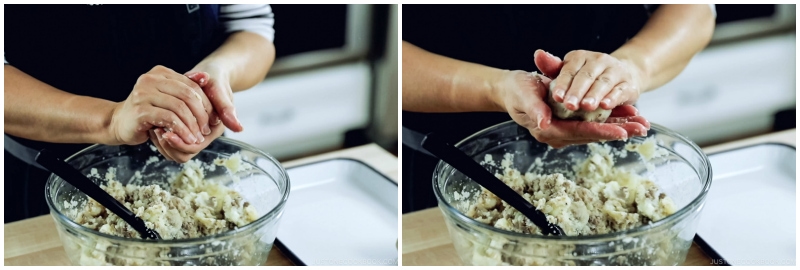






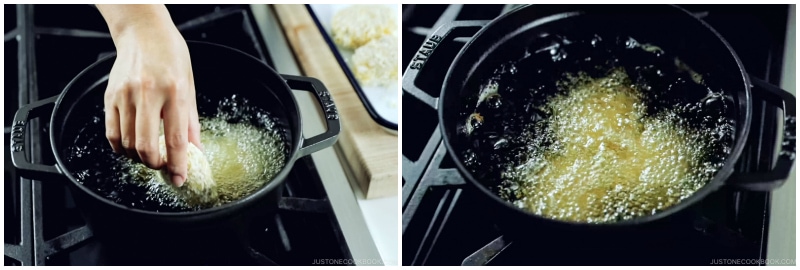
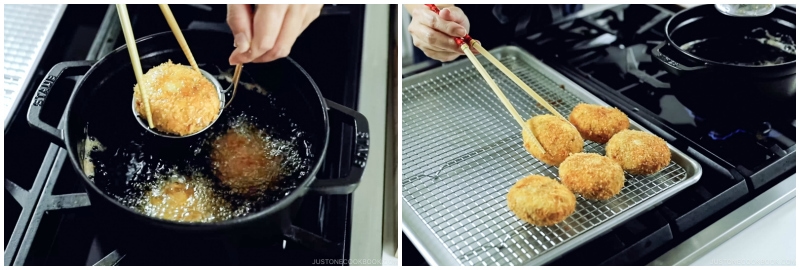












Hi Nami,
can I serve korokke with some tonjiru soup? Or is it too much?
Thank you very much!
I love your recipes!
Ilaria
Hi ilaria, Thank you so much for trying Nami’s recipes!
Yes. You can serve Koroke with Tonjiru soup if you like. It goes well with vegetable miso soup too. That is totally up to your choice. 😉
https://www.justonecookbook.com/vegetable-miso-soup/
We hope this helps!
Hi Nami,
just tried the recipe 🙂 My son, 9 months old, loved them :D!
We however find them ok’ish, since we (Germans) have Kartoffelbrei and Fleischpflanzerl – both packing a stronger punch of flavors!
Cheers 🙂
Hi Pascal, Thank you so much for trying Nami’s recipe and sharing your Korokke photo with us!
We are glad to hear your son enjoyed the flavor! 😊
I love korokke! The baked version is good too, but you cant beat oil fried!
Hello, Andrew! We totally agree! 😃 Your korokke looks amazing!
Thank you very much for tying Nam’s recipe and sharing your Korokke photo with us!
I made these again for the March cooking challenge. They always turn out great, and it’s definitely worth making extra for freezing. It’s also a nice way to use up any leftover mashed potato. 🙂
Hi Sarah! Thank you so much for trying Nami’s recipe and sharing your Korokke photo with us! It looks really good! 🤩
Thank you for participating in our March cooking challenge! We wish you the best of luck!
https://www.justonecookbook.com/joc-cooking-challenge-march-2023/
I know deep fried is the most favorable. But can you also air dry these.
Hi, Lindy! Thank you so much for reading Nami’s post and trying her recipe!
If you follow Nami’s baked Korokke recipe, you should be able to use your air fryer.
https://www.justonecookbook.com/baked-croquette/
We hope this was helpful!
Third time making this recipe! My friends loved it and asked me to make more so they can freeze it and heat it up in the air fryer! 🤍
Hi Yami! Aww.🥰 We are so happy to hear everyone loved Korokke!
Thank you so much for reading Nami’s post and trying her recipe. Happy cooking!😊
What’s up with the shredded cabbage pile and the two random tomato slices?
Hi Janine! Thank you for reading Nami’s post!
Deep-fried foods in Japan are typically served with shredded cabbage and sliced tomatoes. It’s very simple, but it goes well.🙂
We hope you will give it a try!
Where can we get the recipe for the cabbage salad dressing shown in the picture?? It looks great!
Hi Jia! Thank you for reading Nami’s post and trying her recipe!
The dressing is Sesame dressing.
Here is Nami’s recipe:https://www.justonecookbook.com/sesame-dressing/
We hope this helps!
Hi, I want to make a batch and freeze some of it so I can eat them later. Could i freeze them before any breading and then defrost and bread them later when I want?
Hi Susanna! Thank you for reading Nami’s post and trying her recipe!
Yes, you can freeze them before breading.
We hope you enjoy homemade Korokke whenever you want! 😊
Hello! Could this be made vegan if I substituted the ground beef for vegan be’f crumbles or perhaps lentils, etc.?
Sorry! I just realized I missed that portion! Thank you <3
Hi Rivwn! No problem!
For those who want to make a vegan/vegetarian version, you can omit the meat completely. Instead, switch it with finely chopped shiitake mushrooms or other mushrooms you have. You can also add dense vegetables such as corn and carrot, which do not have much moisture, but you can also sauté them until the moisture is evaporated.
We hope you enjoy homemade Croquettes! Thank you for trying Nami’s recipe! 😊
Hi Nami san.
I followed your recipe and the croquettes were so yummy! Thank you. I kept the balance in the freezer. However, when I took them out to thaw, the croquettes turned soft n difficult to hold for frying. How I can I resolve this? I do not like to bake them, as suggested by you.
Thank you again.
Hi Sally, Thank you very much for trying Nami’s recipe!
The Croquette should be able to hold after freezing it. When you freeze it, please make sure not to get stuck together, and try frying the Croquette when it half thaws?
Baking the frozen Croquettes is the easiest way to reheat them, and they turn out crispy as when you just fry them. We hope you give it a try!
I just made these today and it was really good. I did not deep fry them, though. But still, they tasted really good. I used my InstanPot Air Fryer Lid at 350 degrees for 20 minutes. Came out crispy on the outside and moist on the inside. I will look forward to making these again. Thank you for the recipe!
Hi Lee! Wow! Thank you very much for trying Nami’s recipe in the Air Fryer!
We are glad to hear it worked very well.😊
Happy Cooking!
Hi Lee, I’m so glad someone tried them in the air fryer. Did you flip them at the 10 minute mark?
Thanks again!
I’m sorry for the very late reply, I did not get notified of it. Yes, I did flip them at the 10 minute mark.
These look SO delicious, I can’t wait to try making them. Do you have any suggestions for substituting the ground beef to make it a vegetarian/pescatarian version? Thank you!
Hi Rachel, How about replacing the ground beef with mushrooms? Shiitake mushrooms add a good flavor too.
You can also add minced carrot, green pepper, etc.
We hope this helps!
That sounds perfect! Thank you so much!!
You are welcome, Rachel!
Let us know how your vegetarian versions go.😊 We hope you enjoy it.
I’ve always enjoyed croquettes in my local Japanese restaurants, so I thought it would be fun to try to make them myself. This recipe is perfect – my boyfriend and I just love it! When I make them, though, I use bison meat instead of beef. Bison is very lean so there isn’t as much fat to drain from the pan after cooking (it makes that step a bit easier), and its flavour truly shines in recipes with simple ingredients and seasonings like this one. All it really needs it a bit of salt and pepper. If bison meat is available in your area, I would definitely recommend trying it in this recipe.
I also cook my onions a little longer before adding the meat (~25-30 mins) so they caramelize a bit. It adds a bit of extra sweetness that works really well with the rest of the ingredients.
This recipe will definitely be part of my regular cooking rotation from now on. Thank you for sharing it with us!
Hi Sascha! Thank you very much for trying Nami’s recipe and sharing your cooking experience with us!
We are so happy to hear this recipe had added to your list!😊
Wow, I can’t wait to try the recipe. I have been doing a lot of your Japanese recipes lately and my family is enjoying it so much. Thanks for this website!
Hi Chafi! We are so happy to hear you and your family is enjoying Japanese cuisine at home!
Thank you very much for trying Nami’s recipes and for your kind feedback!🥰